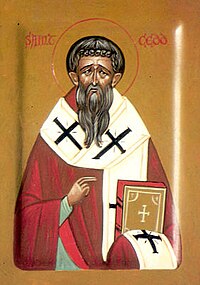Cedd
| Cedd | |
|---|---|
| Bishop of London | |

Modern icon image of Cedd
|
|
| Installed | c. 654 |
| Term ended | 664 |
| Predecessor | Mellitus |
| Successor | Wine |
| Personal details | |
| Born | c. 620 Kingdom of Northumbria |
| Died | 26 October 664 Lastingham |
| Sainthood | |
| Feast day | 26 October, 7 January (Eastern Orthodox Church) |
| Venerated in | Catholic Church; Eastern Orthodox Church; Anglicanism |
| Title as Saint | Evangelist of the Middle Angles and East Saxons |
| Attributes | Bishop holding a model of the church at Bradwell-on-Sea |
| Patronage | Essex; Lastingham; interpreters |
| Shrines | Lastingham. Shrine destroyed in Danish period but corresponding to the crypt of the present parish church |
Cedd (Latin: Cedda, Ceddus; c. 620 – 26 October 664) was an Anglo-Saxon monk and bishop from the Kingdom of Northumbria. He was an evangelist of the Middle Angles and East Saxons in England and a significant participant in the Synod of Whitby, a meeting which resolved important differences within the Church in England. He is venerated in Anglicanism, the Catholic Church and the Eastern Orthodox Church.
The little that is known about Cedd comes to us mainly from the writing of Bede in his Ecclesiastical History of the English People. The following account is based entirely on Book 3 of Bede's History.
Cedd was born in the kingdom of Northumbria and brought up on the island of Lindisfarne by Aidan of the Irish Church. He was one of four brothers: Chad of Mercia (transcribed into Bede's Latin text as Ceadda), Cynibil and Cælin were his siblings. The first datable reference to Cedd by Bede makes clear that he was a priest by the year 653. This probably pushes his birth date back to the early 620s. It is likely that Cedd was oldest of the brothers and was acknowledged the head of the family. He seems to have taken the lead, while Chad was his chosen successor.
Aidan had come to Northumbria from Iona, bringing with him a set of practices that are known as the Celtic Rite. As well as superficial differences over the Computus (calculation of the date of Easter), and the cut of the tonsure, these involved a pattern of Church organization fundamentally different from the diocesan structure that was evolving on the continent of Europe. Activity was based in monasteries, which supported peripatetic missionary bishops. There was a strong emphasis on personal asceticism, on Biblical exegesis, and on eschatology. Aidan was well known for his personal austerity and disregard for the trappings of wealth and power. Bede several times stresses that Cedd and Chad absorbed his example and traditions. Bede tells us that Chad and many other Northumbrians went to study with the Irish after the death of Aidan (651).
...
Wikipedia
